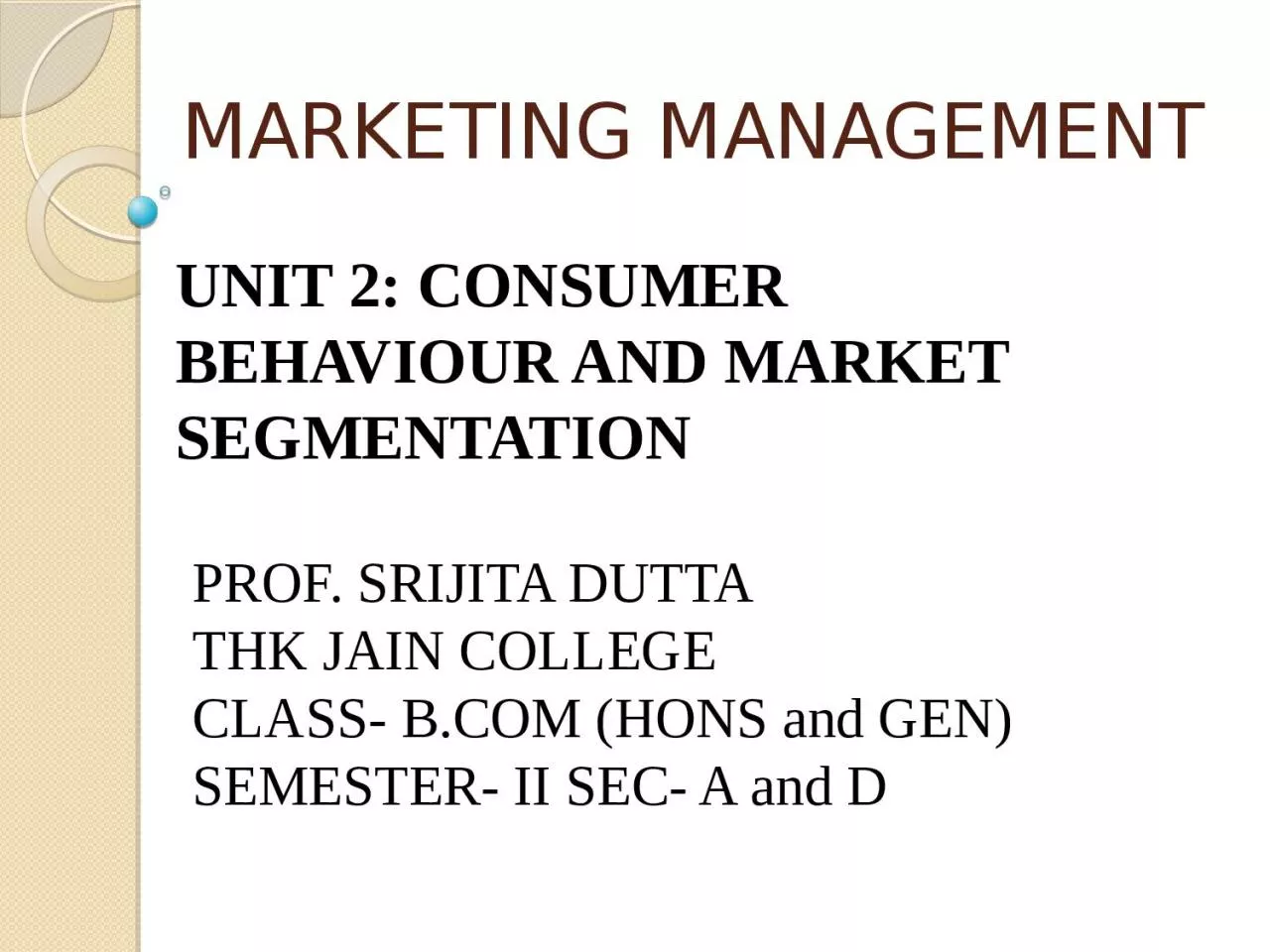

PROF SRIJITA DUTTA THK JAIN COLLEGE CLASS BCOM HONS and GEN SEMESTER II SEC A and D PART 2 MARKET SEGMENTATION Target Marketing A company cannot serve all customers in a broad market The customers are too numerous and diverse in their buying requirements Many companies are embracing ID: 1030033
Download Presentation The PPT/PDF document "MARKETING MANAGEMENT UNIT 2: CONSUMER BE..." is the property of its rightful owner. Permission is granted to download and print the materials on this web site for personal, non-commercial use only, and to display it on your personal computer provided you do not modify the materials and that you retain all copyright notices contained in the materials. By downloading content from our website, you accept the terms of this agreement.
1. MARKETING MANAGEMENTUNIT 2: CONSUMER BEHAVIOUR AND MARKET SEGMENTATIONPROF. SRIJITA DUTTATHK JAIN COLLEGECLASS- B.COM (HONS and GEN) SEMESTER- II SEC- A and D
2. PART 2 MARKET SEGMENTATION
3. Target MarketingA company cannot serve all customers in a broad market. The customers are too numerous and diverse in their buying requirements. Many companies are embracing Target Marketing. Here, sellers distinguish the major market segments and develop products and marketing programs tailored to each. Target Marketing requires marketers to take three major steps:Market SegmentationMarket TargetingMarket Positioning
4. Market SegmentationSegmentation is all about dividing the market, by grouping together customers with similar tastes and preferences in to one segment, to serve it better.Market segmentation is the process of dividing a broad heterogeneous market consisting of existing and potential customers into a number of homogeneous sub-groups on the basis of shared characteristics of customers that is, in respect of similarities of their needs, wants, likes, dislikes, attitudes, tastes, preferences, buying pattern, buying abilities, etc.
5. Importance of Market SegmentationMaximizing customer satisfactionEffective marketing strategiesMaximum customer satisfaction and good customer relationEssence of modern marketingProviding better serviceCapturing opportunities in the marketOptimum utilization of resourcesBenefit of specializationFacing competitionIncrease in profitabilityBenefit to small-scale industries
6. Bases of Market Segmentation
7. Distinction between Product Differentiation and Market SegmentationPRODUCT DIFFERENTIATIONMARKET SEGMENTATION1) Product Differentiation relates to making a product different in terms of product-related qualities, from those offered by competitors.Market segmentation involves breaking down the potential market for a product or service into homogeneous group of customers.2) Product differentiation focuses on imparting a distinctive identity to a product.2) Market segmentation focuses on dividing a large market into small homogeneous sub-markets, on the basis of which marketing efforts may be directed.3) Product differentiation equips an organization to remove price competition faced by a product from its competitors by imparting a distinct identity to the product. 3) Market segmentation equips an organization to expand its target market and orient its marketing efforts on the basis on the attributes of the market segment for which a product is directed.4) Product differentiation emphasises on branding.4) Market segmentation emphasises on customers, both existing and potential.
8. Market TargetingIn Market targeting, marketers must focus their attention on targeting the market segments that are relevant to their products and likely to respond positively to their marketing strategies.Selecting the Market Segments1) Single Segment Concentration: The strategy of targeting a single segment has worked well for some marketers, like Mercedes only concentrates on the upper income group customers.2) Selective Specialization: Automobile manufacturer Hyundai manufactures different models of cars like the Santro, Accent, Verna etc. To cater to different segments with different level of income.3) Product Specialisation: Some companies specialise in a particular product, like Gillette is famous worldwide for its series of shaving products.4) Market Specialisation: Companies like the Ordinance Factories caters to the needs of the Indian defence services by manufacturing different types of arms and ammunitions for them.5) Full Market Coverage: Only very large firms can undertake a full market coverage strategy. Examples include IBM (computer market), General Motors (vehicle market), and Coca-Cola (drink market).
9. Market PositioningPositioning is the act of communicating the company’s offer so that it occupies a distinct and valued place in the customers’ mind. After a company has divided the market into segments and targeted one or more segments, it now needs to establish and communicate the products’ key distinctive benefits to the target group(s) in the market.According to Rooser Reeves, a company should develop an Unique Selling Proposition (USP) for each of its brand. An USP can be any special attributes about the brand like quality, price, service, value, safety provisions, technology etc. Marketers often try to promote the product on the basis of its USP. Number one positioning include ‘best quality’, ‘lowest price’, ‘best value’, ‘best service’, ‘safest’, ‘most advanced technology’ etc.
10. Thank You